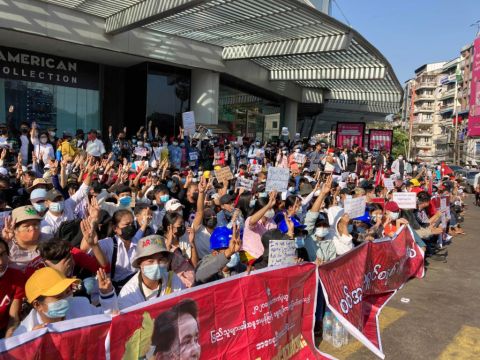Crowds demonstrating against the military takeover in Myanmar have defied a ban on protests, even after security forces ratcheted up the use of force against them and raided the headquarters of ousted leader Aung San Suu Kyi’s political party.
Fresh protests were reported in Yangon and Mandalay, the country’s two biggest cities, as well as the the capital Naypyitaw and elsewhere.
The protesters are demanding that power be restored to Ms Suu Kyi’s deposed civilian government.

They are also seeking freedom for her and other governing party members after their detention in the wake of the military blocking the new session of parliament on February 1.
The military said it acted because November’s election, which Ms Suu Kyi’s National League for Democracy won in a landslide, were marred by irregularities.
The election commission has refuted this allegation.
The growing protests and the junta’s latest raid suggest there is little room for reconciliation.
The military, which held power directly for five decades after a 1962 coup, used deadly force to quash a massive 1988 uprising and a 2007 revolt led by Buddhist monks.

In Naypyitaw and Mandalay on Tuesday, police sprayed water cannon and fired warning shots to try to clear away protesters.
They fired rubber bullets and apparently live rounds, wounding one woman, according to witnesses and footage on social media. The reports could not be independently confirmed.
Human Rights Watch cited a doctor at a Naypyitaw hospital as saying the woman was in critical condition.
The doctor said the woman had a projectile lodged in her head, believed to be a bullet that had penetrated the back of the right ear, and she had lost significant brain function.
The doctor said a man had been also been treated with an upper body wound consistent with a bullet wound.

“Myanmar police should immediately end the use of excessive and lethal force” against the protesters, said the statement from the New York-based watchdog.
Video from Mandalay on Tuesday showed riot police firing into the air and using batons on non-violent demonstrators.
State television network MRTV, in one of its few reports on the protests, broadcast scenes it claimed showed the protesters carrying out the violence.
Protesters have been marching in defiance of orders issued on Monday night banning rallies and gatherings of more than five people, as well as motorised processions, while also imposing an 8pm to 4am curfew.
The orders are issued locally so the extent of the areas covered is hard to gauge, but according to the Myanmar Times newspaper, they cover 90 townships in 30 cities, including all of Yangon and other areas.
On Tuesday night, the military raided the national headquarters of Ms Suu Kyi’s party, which had been slated to take power for a second five-year term before the military seized power.
Kyi Toe, a spokesman for the party, wrote on Facebook that the army broke into the headquarters in Yangon and another office and took away documents and computer hardware.
The headquarters was shuttered on Wednesday.

The United States has “strongly” condemned the violence against demonstrators. State department spokesman Ned Price said Washington would review assistance to Myanmar so that those responsible for the coup face “significant consequences”.
Mr Price added: “We repeat our calls for the military to relinquish power, restore democratically elected government, release those detained, and lift all telecommunication restrictions, and to refrain from violence.”
New Zealand suspended all military and high-level political contact with Myanmar, foreign minister Nanaia Mahuta announced in Wellington, adding that no aid from New Zealand would benefit Myanmar’s military government.
The UN Human Rights Council is to hold a special session on Friday to consider “the human rights implications of the crisis in Myanmar”.
Britain and the European Union spearheaded the request for the session, which will amount to a high-profile public debate among diplomats over the situation in Myanmar and could lead to a resolution airing concerns about the situation or a recommendation of international action.







